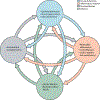Advances in bronchiectasis: endotyping, genetics, microbiome, and disease heterogeneity
- PMID: 30215383
- PMCID: PMC6173801
- DOI: 10.1016/S0140-6736(18)31767-7
Advances in bronchiectasis: endotyping, genetics, microbiome, and disease heterogeneity
Abstract
Bronchiectasis is characterised by pathological dilation of the airways. More specifically, the radiographic demonstration of airway enlargement is the common feature of a heterogeneous set of conditions and clinical presentations. No approved therapies exist for the condition other than for bronchiectasis caused by cystic fibrosis. The heterogeneity of bronchiectasis is a major challenge in clinical practice and the main reason for difficulty in achieving endpoints in clinical trials. Recent observations of the past 2 years have improved the understanding of physicians regarding bronchiectasis, and have indicated that it might be more effective to classify patients in a different way. Patients could be categorised according to a heterogeneous group of endotypes (defined by a distinct functional or pathobiological mechanism) or by clinical phenotypes (defined by relevant and common features of the disease). In doing so, more specific therapies needed to effectively treat patients might finally be developed. Here, we describe some of the recent advances in endotyping, genetics, and disease heterogeneity of bronchiectasis including observations related to the microbiome.
Copyright © 2018 Elsevier Ltd. All rights reserved.
Conflict of interest statement
Conflict of Interest Statement
PAF has research grants with Bayer Healthcare AG, Corbus Pharmaceuticals, Cystic Fibrosis Foundation Therapeutics, Galapagos, Insmed Inc, National Institutes of Health, Novartis, Novoteris, Pro-QR, Proteostasis Therapeutics, Sound Pharmaceuticals, Inc, Vertex Pharmaceuticals, Inc and has served as a consultant to Bayer Healthcare AG, Corbus Pharmaceuticals, Horizon Pharma, Insmed Inc, McKesson, Novartis, Protalix, Proteostasis Therapeutics, Vertex Pharmaceuticals, Inc. JDC has research grants with Astrazeneca, Boehringer-Ingelheim, Glaxosmithkline, Grifols, Bayer. KNO’s former employer, NIAID, had a Cooperative Research and Development Agreement with Insmed, Inc, and his current employer, NHLBI, has Research Agreements with AIT Therapeutics, Inc.
Figures




Comment in
-
Rheumatoid arthritis-associated bronchiectasis.Lancet. 2019 May 18;393(10185):2035-2036. doi: 10.1016/S0140-6736(19)30020-0. Lancet. 2019. PMID: 31106745 No abstract available.
References
-
- Chalmers JD, Aliberti S, Blasi F. Management of bronchiectasis in adults. The European respiratory journal. 2015; 45(5): 1446–62. - PubMed
-
- Araujo D, Shteinberg M, Aliberti S, Goeminne PC, Hill AT, Fardon T, et al. Standardised classification of the aetiology of bronchiectasis using an objective algorithm. The European respiratory journal. 2017; 50(6): 1701289. - PubMed
-
- Spinou A, Siegert RJ, Guan WJ, Patel AS, Gosker HR, Lee KK, et al. The development and validation of the Bronchiectasis Health Questionnaire. The European respiratory journal. 2017; 49(5): 1601532. - PubMed
-
- Polverino E, Goeminne PC, McDonnell MJ, Aliberti S, Marshall SE, Loebinger MR, et al. European Respiratory Society guidelines for the management of adult bronchiectasis. The European respiratory journal. 2017; 50(3): 1700629. - PubMed
Publication types
MeSH terms
Grants and funding
LinkOut - more resources
Full Text Sources
Other Literature Sources
Medical
Miscellaneous

